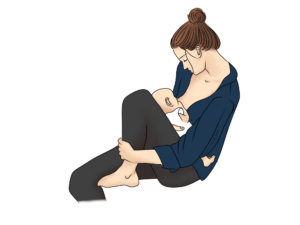The first week of August is Breastfeeding Awareness Week, which may seem irrelevant to osteopathy, but there are a few ways in which breastfeeding can affect your pain. If you are willing and able to breastfeed, it can be a convenient way to feed, with added benefits of passive immunity and mother-baby bonding. Some families prefer to combine breastfeeding with bottles, whether full of pumped milk or formula. This can reduce the demand on the mother, especially if she needs to spend time away from the baby for work or other commitments. Alternatively, some people choose to or have to exclusively formula feed from the start- which can be beneficial in the sense that it removes some of the pain factors listed below. But bottle feeding can also lead you to sit in awkward positions for extended periods, especially if you’re only half awake while doing the night feeds. However you feed, read on to learn about how it could be a factor in your back or shoulder pain, and what you can do about it.
Early Days
It’s not just the mother who needs to learn how to breastfeed, it’s a new skill for baby too. In the first few days, feeding can be painful while you both work to find a good latch. Nipple pain associated with poor latch or clogged ducts can cause you to brace, leading to tension in the neck and shoulders. After the first week, feeding should not be painful. Mention any discomfort to your midwife, and find a lactation consultant if your symptoms do not improve quickly.
Awkward Breastfeeding Positions
Maybe the most obvious connection between breastfeeding and back pain is posture. Like a lot of factors that aggravate our patients symptoms, breastfeeding is an asymmetric activity. In combination with that, you don’t really have a chance to fall back on your stronger side, as you’ll want to try and feed equally on both sides. If baby has a preferred side, due to your flow or any issues with their neck mobility, this can further complicate your positioning. In this case, treatment for your baby is also worth considering. The first thing to do if you notice an achey back, neck, or shoulder while feeding is to tune into your position. Are you well supported? Try sitting in a chair with a back and arm rests, or use cushions to imitate arm rests if that’s not an option. Play around with this until your shoulders are relaxed, and your back softens. Rest your head if you can, or avoid straining to look down at your baby for too long if it’s uncomfortable.
Try Other Positions
Beyond the stereotypical cradle hold, you might find relief with another position, such as:
- Cross cradle hold (cradle hold but with the other arm supporting baby)
- Rugby ball hold
- Reclined
- Side lying
If you don’t get on with a position immediately, try it again in a few weeks as baby’s size and strength play a role in what’s comfortable too. Be aware of safe bedsharing if you do choose to feed laying on your back or side- even if you don’t intend to sleep it may well happen, especially while your baby is waking you up in the night. Don’t make the mistake of believing you won’t drop off- many sleeping accidents happen on the sofa or in an armchair so it is best to always be prepared to fall asleep. If you do feel yourself falling asleep when it’s not safe, put baby in a safe place and take a short nap if you can.
Hormonal Changes While Breastfeeding
You may have felt a bit of lower back or pelvis pain from early on in pregnancy. This may have been partly due to the release of the hormone “relaxin”, which works to relax the ligaments of the pelvis (and beyond). After birth, the level of relaxin in circulation drops, but it takes longer to reduce while you’re breastfeeding. So you might find that some of those joint aches persist for a while, even if you’re not doing anything to aggravate them in terms of feeding position.
For pelvic pain like this, strengthening exercises can be helpful to allow the muscles to support the ligaments. You may also find that altering the way you move takes some of the strain off. Keeping your knees together while getting in and out of a car can help. Getting out of bed by rolling onto your side and putting both legs down together can also limit aggravation to the joints. Of course, your osteopath can work with you too to identify any related factors and treat the whole area.
Osteopathic Treatment
Even if you make every lifestyle change possible, your may still suffer from the aches and pains associated with breastfeeding. Your osteopath can help, looking at the way your back and shoulders move. Alongside osteopathy, physiotherapy can also help by improving posture, reducing muscle tension, and strengthening key areas to support recovery.
Pregnancy itself may have caused some joints in the back to overwork, especially those in the upper back. Stiffness in the thoracic spine can cause the neck and lower back to work harder, and often the stiffness doesn’t cause any pain locally. Some work through the upper back muscles and joints might be all it takes to get you back on track.
We also offer specialist treatment for mothers after birth: the Mummy MOT. This is a comprehensive assessment of the whole body, including an internal pelvic exam to identify the effects of pregnancy and birth. We can then use this information to form a treatment plan to heal the whole body, compensations and all.
